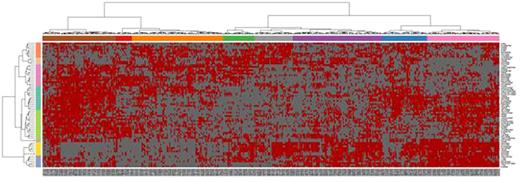Abstract
In an era where the recognized heterogeneity of the pathophysiology of AML is increasing rapidly due to sequencing and other “omics” platforms, and where the number of available targeted therapeutics is also rapidly expanding, a means to individually match therapies to AML on a specific basis is needed. New targeted therapies modulate single pathways, so recognizing when a particular pathway is active is crucial, but mutations are rare within most of these pathways in AML. Furthermore pathway activation can arise by various means. Finally the interaction of multiple different activated pathways on the overall phenotype of a leukemic blast adds complexity.
To define the role of the pathway activation in AML we generated a custom made reverse phase protein array (RPPA) onto which were printed leukemia enriched (ficolled, CD3/CD19 depleted) cells from 511 newly diagnosed AML and 21 APL patients, including 49 with paired diagnosis and relapse samples. Both bone marrow (n=387) and peripheral blood (n=283) samples were used, with 140 cases having both. The RPPA was probed with 231 strictly validated antibodies (174 antibodies vs. total expression, 49 vs. phosphoproteins, 5 vs. cleaved forms, 3 vs. methylation sites). These proteins were divided on the basis of function into 21 Protein function groups (ProFnG) including: Apoptosis, Autophagy, Cell cycle, Creb, Cytoskeletal, Differentiation, Fli1, Hippo, Histone modifying, Hypoxia, Integrin & adhesion, MEK, P53, PI3K-AKT, PKC, SMAD, STAT, Transcription Ubiquitin and Wnt.
Each ProFnGrp was analyzed to determine the optimal number of principal components (PrCp) and to identify noncontributory members, which were then discarded. Each PrCp (79 total) was then considered a variable and Hierarchical clustering was performed on continuous and binary signals (Sokal-Michener metric) (Figure 1). This defined 8 PrCp clusters and 8 patient groups(PatGp). Several categorical clinical features were unevenly associated with the PatGp including FAB (p=1.5e-12), WHO class (p=0.01), gender (p=0.03), Zubrod PS (p=0.005), antecedent hematological disorder (p=0.007), Cytogenetics (0.01), FLT3-ITD (p=0.003), Ras mutation (p=0.003). Likewise many continuous variables also correlated with PatGp: WBC (p=7e-14), %BM blast (p=2x10-16), % PB blast (p=2x10-16), Platelets (p=0.004), LDH (p=0.009), Albumin (p= 0.00001), Creatinine (p=0.007), CD13 (p=0.0002), CD33 (4.5xe-8), CD33 (1.1e-8). For all patients PatGp did not predict remission attainment. There was significant splay in overall survival and event free survival with median EFS durations ranging 52 , 100, 130 and 170 weeks ( p= 0.05) and in remission duration ranging from medians of 20- to 110 weeks. For intermediate cytogenetics Pat-Gps split into 4 with better outcomes (median OS 70-110 week, median RemDur 100-120 weeks) and 4 with worse outcomes (median OS 40-50 weeks, median RemDur 30-40 weeks). For unfavorable cytogenetics Pat-Gps also split into 4 with better outcomes (median OS 35-40 weeks, median RemDur 48-75 weeks) and 4 with worse outcomes (median OS 16-18 weeks, median RemDur 10-26 weeks). In a companion abstract we show the interaction between different protein functional groups.
Heat map of PatGp, clustered as shown along the top based on protein PrCp (y axis right) clustered into 8 protein clusters (y-axis left) shown in binary signal format.
Heat map of PatGp, clustered as shown along the top based on protein PrCp (y axis right) clustered into 8 protein clusters (y-axis left) shown in binary signal format.
AML could be classified based on protein functional groups. Although the classes were associated with cytogenetics the protein classifications gave prognostic information independent of cytogenetics and other traditional prognostic factors. Since this classification scheme is dependent on protein expression and functional activation states it may identify when particular pathways are being utilized and therefore be of use in triaging patients to targeted therapies.
No relevant conflicts of interest to declare.
Author notes
Asterisk with author names denotes non-ASH members.


